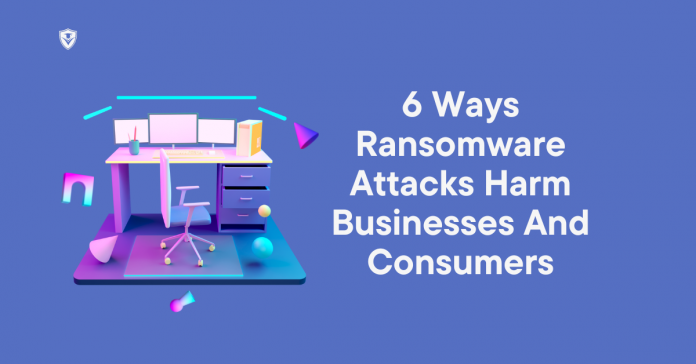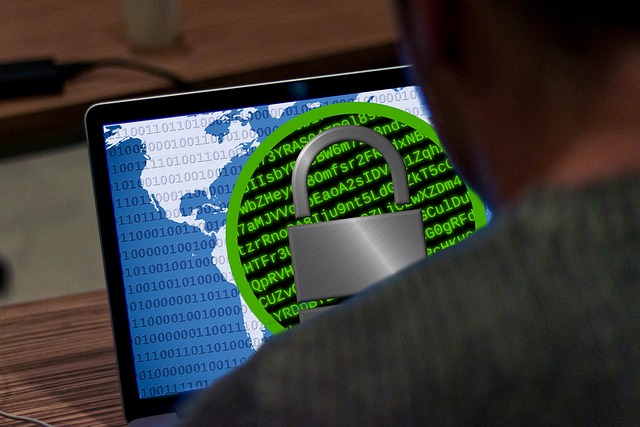Ransomware attacks are big business for hackers with some amassing millions of dollars from a single attack. This was the case when CNA Financial paid some $40 million to retrieve data lost in a 2021 ransomware attack. JBS also paid $11 million in 2021 and Colonial Pipeline paid $4.4 million to attackers to restore the flow of nearly 100 million gallons of fuels that flowed through the pipeline daily.
Of course, most small and medium sized businesses lack the financial resources to weather this type of attack. These costs do not even include other costs associated with cyber-attacks.
Understanding the six ways ransomware attacks harm businesses, and their customers, will help you prioritize your investment in risk avoidance and minimization efforts and encourage the utilization of resources like CISO cybersecurity to reduce your risks.
READ ALSO: Your Essential Ransomware Guide: Prevention, Detection, and Recovery
Table of Contents
6 Ways Ransomware Attacks Harm Businesses And Consumers
1. Lost Data
For some businesses, data is currency. When ransomware attacks occur, businesses are no longer allowed access to their networks and databases. This means that you no longer have access to vital information required to operate your business. You can’t simply use a different computer to do the job.
For this reason, many business owners who would not otherwise pay the ransom demands, do so. The data that has been locked away is far too precious a commodity to refuse. That is what happened in the case of CNA Financial (2021) who paid $40 million to retrieve their data.

2. Costs of Paying or Refusing to Pay Ransom
As discussed earlier, the average ransomware demand is approaching one million dollars in 2022 and some larger businesses have paid substantially more to restore access to their networks.
Some, though, have refused to pay the ransom and this leads to different costs for those who were unprepared and lacked a plan of action to manage the ransomware attack or the funds to pay the demanded ransom. It is far more than the costs of replacing a single computer or even all the computers for your business.
It is about attempting to restore and/or retrieve lost data, determine the breadth of the breach and what customer, employee, privileged, or trade secret information may have been compromised, and of delays and disruptions to your ability to conduct business throughout the process. These costs add up.
READ ALSO: Enterprise Security Guide
3. Supply Line and Distribution Disruptions
In addition to the loss of access to your computers, many businesses are unable to deliver goods, track goods, or manage their supply lines while a ransomware attack is underway.
While it would be nice if you were able to snap your fingers and come up with the funds to pay the ransom, most businesses aren’t that fortunate. It may take hours, days, or even weeks to meet the demands and restore your systems. During this time, you are unable to conduct business. That means goods are not delivered and revenue is not received.
4. Reputation Damage
Perhaps one of the costliest results of a ransomware attack is the loss of reputation businesses suffer.
Many small businesses are never able to recover after an attack such as this. Once consumers lose faith in a business, the path to restoring that faith and rebuilding your reputation is long and costly.
5. Legal Concerns and Restitution
Then there are the legal ramifications. The truth is that businesses are responsible for safeguarding customer and employee information that is entrusted to them.
Whether it is financial information, private information, health details, confidential or privileged materials, or something else, your business can be held financially responsible for damages related to data breaches that occur on your watch.
6. Increased Vulnerability to Future Attacks
Finally, once a single attack occurs and the vulnerability has been exploited once, businesses become prime targets for future attacks.
Some happening immediately once systems are restored. In fact, many cyber attackers share information about vulnerabilities discovered during the attack so other attackers can take advantage of them.
Frequently Asked Questions About Ransomware Attacks
How can I protect myself from ransomware attacks?
- Regular Backups: Maintain backups of your data on a separate, secure system to restore information in case of an attack.
- Software Updates: Keep your operating system, applications, and security software up-to-date to patch vulnerabilities.
- Beware of Phishing: Don’t click on suspicious links or attachments in emails or messages.
- Strong Passwords: Use strong, unique passwords for all your online accounts and enable two-factor authentication when available.
- Security Software: Invest in a reputable antivirus and anti-malware program to detect and block potential threats.
What should I do if I get hit by a ransomware attack?
- Do not pay the ransom: Paying encourages attackers and doesn’t guarantee data recovery, especially cryptocurrencies such as Bitcoin, Dogecoin, Ethereum, etc.
- Disconnect affected devices: Isolate infected computers from your network to prevent further spread.
- Report the attack: Inform law enforcement and relevant authorities to help track down the attackers.
- Seek professional help: Consider consulting cybersecurity professionals to assist with data recovery and remediation efforts.
Can ransomware attacks be completely prevented?
There’s no foolproof way to prevent an attack, but implementing strong security practices and staying vigilant can significantly reduce the risk.
Are there different types of ransomware?
Yes, ransomware can target different types of devices and systems. Some variants focus on encrypting personal data on individual computers, while others target enterprise networks and servers.
What is the future of ransomware attacks?
Cybercriminals are constantly evolving their tactics. It’s crucial to stay informed about the latest threats and adapt your security measures accordingly.
Preventing Ransomware Attacks For Your Business
There is quite a bit of doom and gloom related to ransomware attacks. In fact, there’s nothing good that ever comes of them.
Even if you pay the ransom, there are no guarantees that your systems will be fully restored without serious ramifications to your businesses, your customers, and the people who work for you.
That is why prevention is, by far, the best cure for ransomware attacks. Keep your information backed up daily, train your employees to avoid ransomware attacks, and consider bringing in a consultant to assess your security plan and help you further minimize your cyber risks.
INTERESTING POSTS
- What is Ransomware? Signs and How to remove it?
- How APIs Help To Improve Your Customers’ Experience [5 Tips]
- Is Voltage Stabilizer Required For Inverter AC?
- 4 Ways Ransomware Can Infect A System
- How to Protect Your Computer from Ransomware: Essential Security Measures
- Understanding The Windows 10 Ransomware Protection
About the Author:
Christian Schmitz is a professional journalist and editor at SecureBlitz.com. He has a keen eye for the ever-changing cybersecurity industry and is passionate about spreading awareness of the industry's latest trends. Before joining SecureBlitz, Christian worked as a journalist for a local community newspaper in Nuremberg. Through his years of experience, Christian has developed a sharp eye for detail, an acute understanding of the cybersecurity industry, and an unwavering commitment to delivering accurate and up-to-date information.








